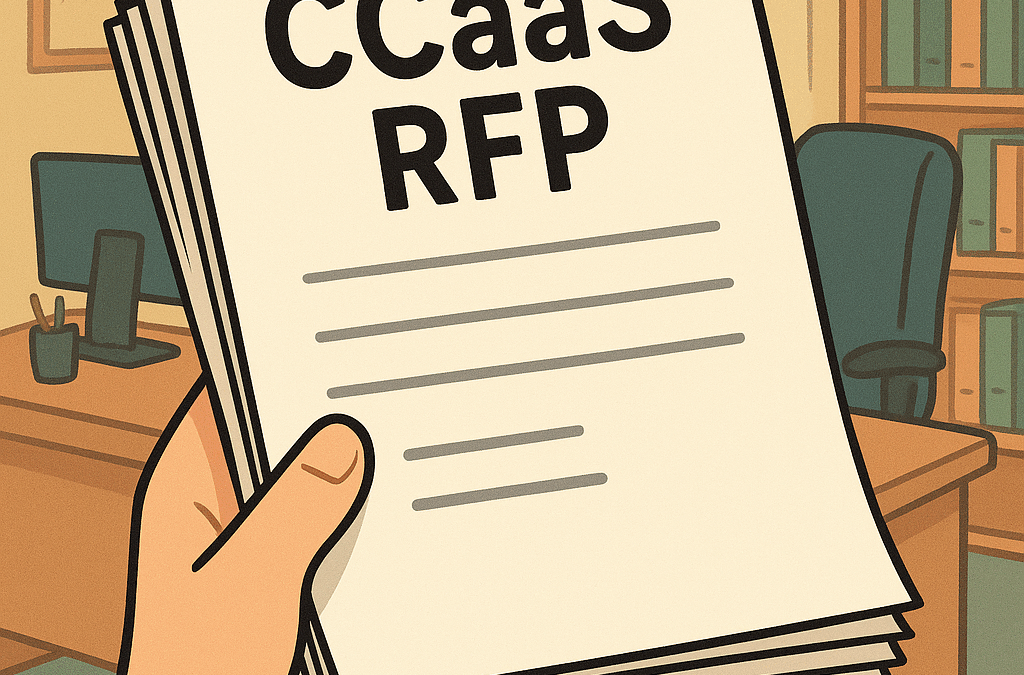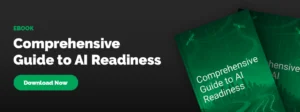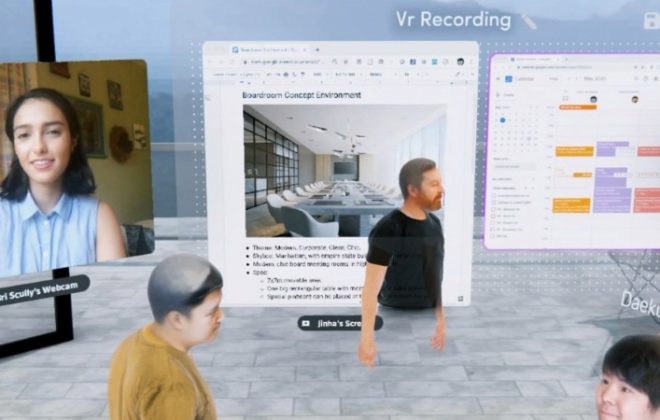AI in CCaaS RFPs: Essential Features for Next-Gen Contact Centers
Customer experience (CX) has become the ultimate battleground for competitive advantage. In an era when customers expect faster, smarter, and more personalized service, traditional contact center solutions are no longer enough. Companies are migrating to Contact Center as a Service (CCaaS) platforms to gain flexibility, scalability, and access to new digital channels. Yet one critical element is often overlooked during the RFP process: artificial intelligence.
Too many organizations still approach their CCaaS RFP as if they are buying telephony infrastructure. The result is a request for proposals that focus on pricing, call routing, and compliance checklists—but fail to require advanced AI capabilities that define the modern contact center. Plan strategically out to 2035 since leaving AI out of your CCaaS RFP is not just a missed opportunity; it is a strategic risk.
Why AI Has Become Essential in CCaaS
Customer expectations have shifted dramatically. They want seamless, omnichannel service that is available 24/7, whether they are chatting on a website, calling from a smartphone, or engaging through social media. They also expect brands to recognize them, anticipate their needs, and resolve their issues quickly. AI is the only way to deliver at this scale.
AI-driven CCaaS platforms enable organizations to reduce average handle time, improve first-call resolution, and deliver consistent experiences across every channel. More importantly, they help agents perform better by providing real-time coaching, sentiment analysis, and knowledge suggestions. The companies that lead in CX today are those that have woven AI deeply into their contact center operations, and they are seeing higher Net Promoter Scores, stronger customer loyalty, and measurable cost savings.
The Risks of Ignoring AI in Your RFP
Leaving AI out of your CCaaS RFP locks your organization into yesterday’s workflows. Without AI, agents spend more time searching for answers instead of serving customers. Customers wait longer in queues, face more transfers, and leave interactions less satisfied.
The lack of AI-powered automation also increases operational costs. Competitors who deploy AI are deflecting routine inquiries to intelligent virtual agents, optimizing agent schedules, and predicting call volumes with accuracy. Meanwhile, companies without AI remain stuck with higher labor costs, lower efficiency, and weaker insights into customer behavior. Over time, this competitive lag becomes more difficult to close, making the contact center a liability rather than a differentiator.
Key AI Capabilities to Include in Your CCaaS RFP
When drafting your CCaaS RFP, it is essential to articulate specific AI capabilities rather than simply asking if a vendor “uses AI.” Vendors often claim to be AI-driven, but the reality varies widely. To protect your investment, your RFP should outline requirements across several dimensions. A top AI consultant, who has a legacy of contact center consulting and global wide area network, can be a great resource to guide your team from a third-party perspective. Also, see our article on Network Design for the AI Era.
First, prioritize conversational AI and virtual agents that use natural language processing to understand customer intent. Look for solutions that support multiple languages, can integrate with your knowledge base, and improve over time with machine learning. These AI assistants should not only deflect calls but also escalate seamlessly to live agents when necessary.
Second, demand robust agent assist tools. Modern CCaaS platforms should provide real-time recommendations, highlight customer sentiment during calls, and surface relevant content from knowledge libraries. This reduces the burden on new agents and shortens training cycles.
Third, evaluate predictive routing and workforce optimization features. AI-driven routing ensures that each customer reaches the best-fit agent, whether that decision is based on expertise, sentiment, or predicted outcomes. Intelligent workforce tools can balance workloads and predict staffing needs, improving both employee satisfaction and cost efficiency.
Fourth, require AI-powered analytics. Speech and text analytics allow supervisors to review every interaction for compliance, coaching, and quality. Predictive analytics can forecast churn, identify trending issues, and uncover opportunities to improve products and services.
Finally, address compliance and security. Modern AI can detect anomalies, flag compliance risks, and reduce fraud in real time, protecting both customers and the enterprise.
How to Frame AI in Your RFP Requirements
The most effective RFPs go beyond features to define business outcomes. Rather than simply asking for AI virtual agents, specify that you want to reduce average handle time by 15 percent, or that you expect to increase first-call resolution by 20 percent. Vendors should be required to provide real-world case studies that demonstrate measurable results.
Your RFP should also address transparency in AI. Ask how vendors train their models, whether they mitigate bias, and how they ensure data security. Require a roadmap of future AI innovation so you can assess whether the platform will evolve with your needs.
By writing your requirements in terms of business goals, transparency, and vendor commitment, you not only filter out weak providers but also set your contact center up for long-term success.
Evaluating Vendors Beyond the Buzzwords
The term “AI” is used so broadly in the contact center industry that it can be difficult to separate genuine capabilities from marketing hype. This phenomenon, sometimes called “AI-washing,” makes careful evaluation essential.
During vendor assessments, look beyond sales slides. Request demos that show real-time AI in action, ask for proofs of concept, and check customer references. Evaluate the vendor’s partner ecosystem to ensure seamless integration with your CRM, workforce optimization tools, and analytics platforms.
The vendors that stand apart will be those that demonstrate tangible AI benefits today while providing a credible roadmap for the future.
The Business Case: AI ROI in Contact Centers
Including AI in your CCaaS RFP is not just about keeping up with trends; it is about building a strong business case. Companies that deploy AI in their contact centers often see a double benefit: reduced costs and higher customer satisfaction.
Labor costs are reduced because routine inquiries are handled by AI-powered self-service, while predictive staffing ensures agents are scheduled more efficiently. Customer experience improves because calls are routed more intelligently, agents receive better support, and analytics uncover opportunities for proactive engagement.
The ROI of AI in contact centers can be measured in months rather than years, with many organizations reporting payback within the first year. In addition to quantifiable savings, the intangible benefits—such as improved employee morale and stronger brand reputation—are equally important.
Future-Proofing Your Contact Center Strategy
AI is evolving rapidly. Generative AI, autonomous agents, and hyper-personalization are already reshaping how companies engage with customers. By embedding AI requirements in your CCaaS RFP today, you are not only solving current challenges but also ensuring your contact center remains agile and scalable tomorrow.
AI is no longer a feature; it is the foundation of digital-first customer experience. Companies that align their CCaaS strategy with AI will be better equipped to adapt, grow, and outperform competitors in the years ahead.
Conclusion
The message is clear: if you are planning a CCaaS RFP, AI cannot be an afterthought. It must be a core requirement, woven into every aspect of your evaluation. By doing so, you ensure that your next-generation contact center will not only meet today’s expectations but also anticipate tomorrow’s opportunities. Reach out to us at Macronet Services anytime for a conversation about how to compete with CX in the AI era.
Frequently Asked Questions (FAQs)
- Why should AI be included in a CCaaS RFP?
Including AI ensures your contact center delivers faster, smarter, and more personalized customer experiences while lowering operational costs. - What AI features are most important in CCaaS?
The most critical features include conversational AI, real-time agent assist, predictive call routing, speech and text analytics, and AI-powered workforce optimization. - How does AI improve customer satisfaction in contact centers?
AI reduces wait times, resolves issues more quickly, provides personalized service, and equips agents with real-time insights, all of which increase CSAT and NPS scores. - What is “AI-washing” in contact center technology?
AI-washing is when vendors market basic automation as “AI.” It highlights the need for businesses to demand demos, proofs of concept, and measurable outcomes in their RFPs. - Can AI help reduce contact center costs?
Yes. AI deflects routine inquiries to virtual agents, optimizes staffing schedules, reduces average handle time, and improves overall efficiency, all of which lower costs. - How does AI support compliance in CCaaS platforms?
AI-powered analytics monitor interactions for compliance risks, detect anomalies, and help prevent fraud or data breaches in real time. - What role does AI play in agent performance?
AI provides real-time recommendations, sentiment tracking, and knowledge suggestions, which shorten training cycles, reduce errors, and improve first-call resolution rates. - How do I evaluate AI claims in vendor proposals?
Ask vendors for case studies, live demos, and references. Require transparency on how AI models are trained, how data is secured, and what results clients have achieved. - What ROI can I expect from AI in a contact center?
Most organizations achieve ROI within 6–12 months through reduced labor costs, improved CSAT, higher agent productivity, and increased retention. - Is AI in CCaaS future-proof?
Yes. By requiring AI in your RFP, you position your contact center to adopt emerging technologies like generative AI, hyper-personalization, and autonomous customer engagement.
Related Posts
Recent Posts
- Telecom Expense Management (TEM): The Definitive Guide for Mid-Large Enterprises
- Designing Secure and Compliant Networks in China: The Definitive Guide for Global Enterprises
- Securing Autonomous AI Agents: Identity-Anchored Autonomy for Enterprise Risk & Resilience
- The Definitive Guide to Enterprise Telecom Agreements: MSA, SLA, and DIA Negotiation Best Practices for Global Carriers
- The AI Privacy Engineer: Architecting Trust and Compliance in the Age of AI
Archives
- December 2025
- October 2025
- September 2025
- August 2025
- July 2025
- June 2025
- May 2025
- April 2025
- March 2025
- February 2025
- January 2025
- December 2024
- November 2024
- October 2024
- September 2024
- August 2024
- July 2024
- June 2024
- May 2024
- April 2024
- March 2024
- February 2024
- January 2024
- December 2023
- November 2023
- October 2023
- September 2023
- August 2023
- July 2023
- June 2023
- May 2023
- April 2023
- March 2023
- February 2023
- January 2023
- December 2022
- November 2022
- October 2022
- September 2022
- August 2022
- July 2022
- June 2022
- May 2022
- April 2022
- March 2022
- February 2022
- January 2022
- December 2021
- November 2021
- October 2021
- September 2021
- August 2021
- July 2021
- June 2021
- May 2021
- April 2021
- March 2021
- December 2020
- September 2020
- August 2020
- July 2020
- June 2020
Categories
- Clients (12)
- Telecom Expense Management (1)
- Satellite (1)
- Artificial Intelligence (9)
- Travel (1)
- Sports (1)
- Music (1)
- News (281)
- Design (4)
- Uncategorized (1)
- All (19)
- Tips & tricks (25)
- Inspiration (9)
- Client story (1)
- Unified Communications (196)
- Wide Area Network (309)
- Cloud SaaS (60)
- Security Services (71)






